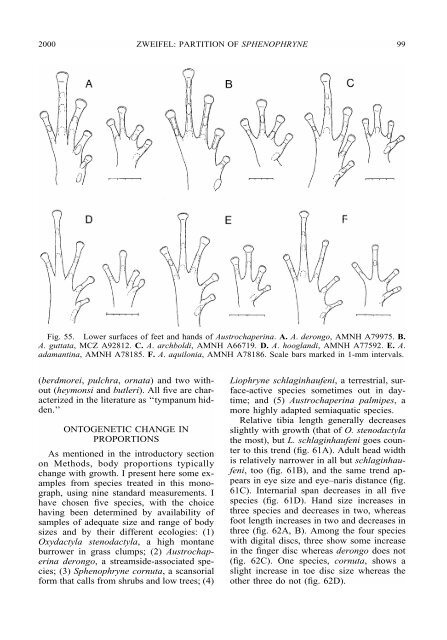SPHENOPHRYNE - American Museum of Natural History
SPHENOPHRYNE - American Museum of Natural History
SPHENOPHRYNE - American Museum of Natural History
You also want an ePaper? Increase the reach of your titles
YUMPU automatically turns print PDFs into web optimized ePapers that Google loves.
2000 ZWEIFEL: PARTITION OF <strong>SPHENOPHRYNE</strong><br />
99<br />
Fig. 55. Lower surfaces <strong>of</strong> feet and hands <strong>of</strong> Austrochaperina. A. A. derongo, AMNH A79975. B.<br />
A. guttata, MCZ A92812. C. A. archboldi, AMNH A66719. D. A. hooglandi, AMNH A77592. E. A.<br />
adamantina, AMNH A78185. F. A. aquilonia, AMNH A78186. Scale bars marked in 1-mm intervals.<br />
(berdmorei, pulchra, ornata) and two without<br />
(heymonsi and butleri). All five are characterized<br />
in the literature as ‘‘tympanum hidden.’’<br />
ONTOGENETIC CHANGE IN<br />
PROPORTIONS<br />
As mentioned in the introductory section<br />
on Methods, body proportions typically<br />
change with growth. I present here some examples<br />
from species treated in this monograph,<br />
using nine standard measurements. I<br />
have chosen five species, with the choice<br />
having been determined by availability <strong>of</strong><br />
samples <strong>of</strong> adequate size and range <strong>of</strong> body<br />
sizes and by their different ecologies: (1)<br />
Oxydactyla stenodactyla, a high montane<br />
burrower in grass clumps; (2) Austrochaperina<br />
derongo, a streamside-associated species;<br />
(3) Sphenophryne cornuta, a scansorial<br />
form that calls from shrubs and low trees; (4)<br />
Liophryne schlaginhaufeni, a terrestrial, surface-active<br />
species sometimes out in daytime;<br />
and (5) Austrochaperina palmipes, a<br />
more highly adapted semiaquatic species.<br />
Relative tibia length generally decreases<br />
slightly with growth (that <strong>of</strong> O. stenodactyla<br />
the most), but L. schlaginhaufeni goes counter<br />
to this trend (fig. 61A). Adult head width<br />
is relatively narrower in all but schlaginhaufeni,<br />
too (fig. 61B), and the same trend appears<br />
in eye size and eye–naris distance (fig.<br />
61C). Internarial span decreases in all five<br />
species (fig. 61D). Hand size increases in<br />
three species and decreases in two, whereas<br />
foot length increases in two and decreases in<br />
three (fig. 62A, B). Among the four species<br />
with digital discs, three show some increase<br />
in the finger disc whereas derongo does not<br />
(fig. 62C). One species, cornuta, shows a<br />
slight increase in toe disc size whereas the<br />
other three do not (fig. 62D).
















